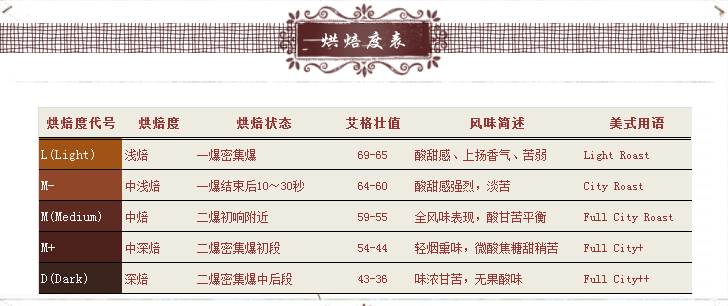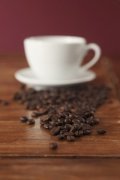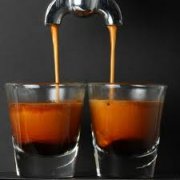Boutique coffee baking knowledge coffee roasting training
When coffee beans grow on trees, they change from green to red. After harvest, they are selected, peeled, dried, and so on. What comes out is the so-called coffee beans. At this time, we call them raw beans, which are green. (the color varies according to the way it is handled. Generally speaking, the color of washing is darker and the color of dry is lighter.) Before making a drinkable coffee, it should be baked and processed to stir-fry its flavor. The taste of coffee mainly depends on the roasting technology, which is roughly divided into three roasting degrees (8 roasting degrees, 6 roasting degrees and so on): light roasting (shallow roasting), moderate roasting and deep roasting.

To put it simply, when coffee beans are roasted, calories cause chemical changes in the beans, turning starch in raw beans into sugars and acids, and proteins into enzymes, forming an aromatic coffee oil on the surface of the beans (the deeper the roast is, the more obvious it is). At the same time, water and carbohydrates are evaporated. Roasted coffee beans are about twice as large as raw beans because the water vapor and carbon dioxide produced during baking put pressure on the cell wall, but because the cell wall is very resilient, so the beans only expand and do not break. Personally, I think the expansion of coffee beans is closely related to the water content of raw coffee beans and the growing environment of coffee beans. I did a simple baking experiment at the beginning. Without considering the roaster, the fresh raw coffee beans with high altitude and high water content are more difficult to expand normally. I also call the surface of coffee beans difficult to unfold and uneven. Low altitude, Chen beans, dried beans are easier to bake, and the shape of the baked beans is quite beautiful.)
The roasting of coffee beans ranges from the oldest copper and iron pans to today's fully automatic machine baking, the equipment used is constantly updated, but the taste of baking depends on the experience of baking. Its different depth of baking produces different sour and bitter. The deeper the roasting, the stronger the aroma of the coffee (in this case, the depth of the aroma of coffee beans). Light baking is sour and light brown; moderate roasting loses sour taste and the real brown color; deep baking loses all sour taste, the color is close to black, and its scorched flavor makes the coffee flavor stronger (this deep coffee flavor is preserved for a short time. I think that in the case of packaging and storage for about three months, the time has been long, and the taste is very strange.) . Countries such as Italy (mainly in the south), France and the United States (more in southern Seattle) like to roast coffee until it is nearly carbonized in order to feel the strong aroma of coffee.
The roasting of coffee bean flavor depends entirely on the roaster's understanding of coffee beans and their taste (which is the same as when making coffee and drinking coffee). For example, Brazil coffee beans are mostly roasted in the market. because of the characteristics of this coffee bean itself (the characteristics of coffee beans have to be tested many times, the flavor of different estates is so detailed that there are considerable differences in flavor. This is similar to red wine. What we are talking about here is the general characteristics of coffee beans, generally speaking, the characteristics of a country or a large coffee producing area.) Comparatively flat, bitter, sour taste is not very prominent, the production of coffee is not high mellow. In general, this flavor of coffee beans will be roasted to moderate roasting, its full flavor, less miscellaneous flavor, the most acceptable. For example, Mantenin coffee beans, its bitter taste is heavy, too shallow roasting is easy to make coffee sour taste to take away the bitterness. Therefore, this kind of coffee beans are generally roasted to a medium-deep degree, so that its flavor reaches a certain balance.
To put it simply, the choice of roasting degree of coffee beans mainly depends on the market demand and the roaster's personal hobbies. Just like some people like to drink black coffee, some people like to drink milk coffee ~ who says Brazilian beans must be roasted to medium?
Important Notice :
前街咖啡 FrontStreet Coffee has moved to new addredd:
FrontStreet Coffee Address: 315,Donghua East Road,GuangZhou
Tel:020 38364473
- Prev

Basic knowledge of Fine Coffee coffee Grinding equipment
There are different brands and models of bean grinder, and the grinder which can adjust the thickness of grinding bean is ideal. When grinding with a bean grinder, don't grind too much at one time, just enough for one use. Because the longer the bean grinder is used at one time, the easier it is to heat up, which indirectly causes the coffee beans to be heated and leads to the loss of aroma, thus affecting the aroma of coffee. Coffee beans contain oil lu.
- Next

General knowledge of boutique coffee baking and making espresso
Today we are going to study a coffee roasting training course to compare the differences between espresso and other immersion brewing methods (such as French pressing and trickling). Recently, I have just received a sample bean, and I can't wait to bring the ceramic cup testing pot I have just got. After I injected hot water into the prepared sample bean for about five minutes, the bean showed lively.
Related
- Beginners will see the "Coffee pull flower" guide!
- What is the difference between ice blog purified milk and ordinary milk coffee?
- Why is the Philippines the largest producer of crops in Liberia?
- For coffee extraction, should the fine powder be retained?
- How does extracted espresso fill pressed powder? How much strength does it take to press the powder?
- How to make jasmine cold extract coffee? Is the jasmine + latte good?
- Will this little toy really make the coffee taste better? How does Lily Drip affect coffee extraction?
- Will the action of slapping the filter cup also affect coffee extraction?
- What's the difference between powder-to-water ratio and powder-to-liquid ratio?
- What is the Ethiopian local species? What does it have to do with Heirloom native species?

